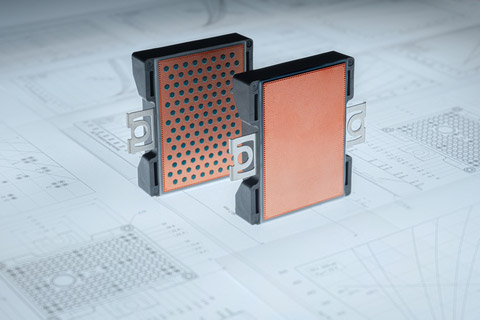News: Microelectronics
10 September 2024
Wolfspeed unveils 2300V baseplate-less SiC power modules for 1500V DC bus applications
Wolfspeed Inc of Durham, NC, USA — which makes silicon carbide (SiC) materials and power semiconductor devices — has unveiled a silicon carbide module designed to transform the renewable energy, energy storage and high-capacity fast-charging sectors through improved efficiency, durability, reliability and scalability. The 2300V baseplate-less silicon carbide power modules for 1500V DC bus applications were developed and launched utilizing Wolfspeed’s 200mm silicon carbide wafers.

Picture: Wolfspeed’s 2300V baseplate-less silicon carbide power modules for 1500V DC bus applications.
Wolfspeed is also partnering with North American utility-scale inverter manufacturer EPC Power, which will be employing the Wolfspeed modules in utility-grade solar and energy storage systems, offering a scalable high-power conversion system and high-performance controls and system redundancy.
“The solar and energy storage market remains among the fastest-growing segments of the renewable energy industry. As the pioneers of silicon carbide, we are driven to create solutions that will open the door to a new era of modern energy,” says Jay Cameron, Wolfspeed senior VP & general manager, Power. “Energy efficiency, reliability and scalability are top of mind for our customers, such as EPC Power, who recognize the substantial advantages Wolfspeed’s silicon carbide brings to the table,” he adds.
“Silicon carbide devices open the door to a step-change in inverter performance and reliability,” says EPC Power’s president & CEO Devin Dilley. “With our commitment to extreme reliability, performance and security in our new ‘M’ inverter while also forging a deep commercial relationship with key suppliers, Wolfspeed was the obvious choice,” he adds.
With mounting global investment in renewable energy, the solar energy market will reach a $300bn market capitalization by 2032, forecasts Allied Market Research. According to the International Energy Agency (IEA), 2024–2025 will see the highest energy demand growth rate since 2007, reinforcing the need for efficient and reliable clean power. Wolfspeed says that its silicon carbide solution helps to bridge this crucial gap, supporting the next era of modern energy technologies while reinforcing US clean energy manufacturing leadership.
“This platform further validates our investments in 200mm wafer technology and production as the potential of silicon carbide continues to be recognized by industry leaders across all mission-critical applications,” says Cameron.
Switching performance
Wolfspeed says that its 2300V modules can improve system efficiency while reducing the number of passive components. They offer 15% greater voltage headroom compared with similar silicon carbide modules, improved dynamic performance with consistent temperature stability, and a substantial reduction in EMI filter size, it is claimed. The firm adds that its technology achieves a 77% reduction in switching losses over IGBTs and a 2–3x reduction in switching losses for silicon carbide devices intended for 1500V applications.
Market scalability through design simplification
2300V silicon carbide modules will allow system designers to leverage lower-cost printed circuit boards to cut manufacturing costs and significantly reduce development time compared with legacy bus bar solutions. Furthermore, Wolfspeed’s 2300V modules can enable the industry to adopt the two-level topology, resulting in simplified system design and reduced driver count compared with IGBT-based three-level configurations. The benefits of 2300V modules support a building-block approach to easily scale power tenfold, from kilowatts to megawatts.
Prolonged system lifetimes & durability
Wolfspeed says that its 2300V silicon carbide modules can allow customers to further enhance the lifetime and durability of their systems. This is achieved through an optimized failure-in-time rate for continuous 1500V DC operation and improved cosmic ray susceptibility compared with a 2000V design. When used in a two-level implementation, 2300V modules reduce the amount of potential single points of failure across the system.









